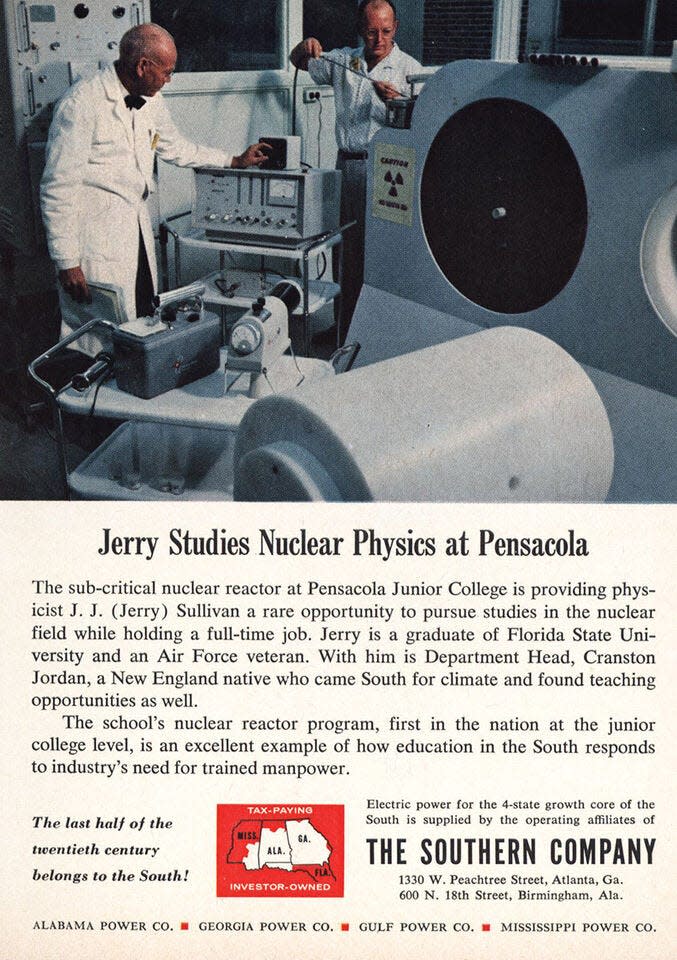Pensacola State College once had nuclear reactor - whatever happened to it?
So, who knew that Pensacola Junior College was the first junior college in the nation to have its own nuclear reactor and was primed to lead and educate a new generation of nuclear physicists and engineers during the rather warm Cold War.
Say what?
That's right, PJC, now Pensacola State College, received its Lockheed-built sub-critical nuclear reactor in February 1961 after it received approval from the Atomic Energy Commission to purchase and house a nuclear reactor. The college received a federal grant to purchase the reactor for $34,500.
It was going to be a big deal and put Pensacola at the forefront of nuclear training. There were even large color advertisements in magazines across the United States touting PJC's nuclear reactor and training program.
As evidenced by the magazine advertisements and numerous articles in newspapers across the nation written about the college's rare reactor, PJC hoped to use it not only for research and training, but to increase its prominence.
Then-PJC President Henry Ashmore told the Pensacola Chamber of Commerce at the time that the college's nuclear program was "aimed at training technicians so that men with masters and doctor (sic) degrees could be freed to do the more difficult jobs in the atomic program." He said the reactor would bring Pensacola and PJC "great prestige" (Yeah, we noticed the "so that men with ..." part too. It was 1961. "That Girl" wouldn't even be out for five more years).
So how did that "great prestige" thing work out?
PJC sold the reactor just three years later to an unnamed Florida engineering school, according to a 1964 PNJ article. It quoted one school official, despite the former fanfare, as saying PJC's nuclear program "has not proved feasible."

Pensacola voice actor Robin Rowan contacted the Pensacola News Journal recently about the reactor after finding one of the advertisements and a visitor's guide PJC used to promote the nuclear reactor.
"I had never heard of it before," Rowan said of seeing the advertisements. "Had you?" (No. Thanks Robin).
The advertisements were sponsored by The Southern Company, which was then the parent company of Gulf Power, now Florida Power & Light. The ads were featured in publications such as U.S. News & World Report, the Wall Street Journal, Reader's Digest, the Saturday Evening Post, Business Week and many more. The advertising caught millions of eyes, for sure.
The reactor, which used "enriched fuel," according to Ashmore, would be used "for training students in the application of nuclear engineering fundamentals." The enriched fuel source Ashmore referred to was Uranium 238 enriched with a 20% mixture of the more-potent Uranium 235. The reactor's core was 10 inches in diameter and 14 inches long. PJC's reactor was housed in the college's Science building.
One PNJ article said that some students had vowed not to park or walk near the reactor's vicinity.
But Thomas Wellock, official historian for the U.S. Nuclear Regulatory Commission, said there probably wasn't much to worry about at the college, which celebrates its 75th anniversary this year. (PJC became PSC in 2010.)
"It wasn't what we really think of as a nuclear reactor," Wellock said. "It was a subcritical reactor which means it wouldn't quite get there." "There" being, you know, nuclear accidents, fallout and all the things that make disaster movies awesome.
Wellock said there are no real records of PJC's reactor, and he too wondered what happened to it. But he said there was a push across South in the second half of the 20th century to showcase the technology achievements and potential of the then oft-maligned region. (Yeah, it's still maligned.)
He said it was because it was a sub-critical reactor that there is little recorded information on it. Wellnock suspects the college dropped the program and sold the reactor for a what could be a variety of reasons, from insurance costs to the expense for upkeep. That also happened across the South as more and more reactors were manufactured.
He agreed with PJC's admission at the time of the sale that the nuclear reactor at PJC wasn't feasible.
More like this: See PSC's new, state-of-the-art $22.5M math and technology center
"It was just too complicated for a junior college,'' he said.
PSC President Ed Meadows said he had heard about the reactor years ago, but admitted he didn't have much information about it. And despite the college abandoning its nuclear program - too bad, the Atomic Pirates sounds cool - Meadows said PSC is still committed to instructing its students in advanced technology and partnering with companies and agencies to help students land jobs in fields ranging from robotics to artificial intelligence.
PSC's new Bear, Jones, Moore, and Reeves Advanced Technology Building on the campus has its grand opening on Oct. 30. The more than 46,000-square-foot facility will be used for math and computer science classes and include an emerging technology lab, computer and information center science labs, a 3D prototyping area, a rooftop terrace, faculty offices and more. (No nuclear reactor or that sort of thing, though). The facility cost about $23 million.
(That kind of money apparently would have bought you about 666.666 nuclear reactors back in the early 1960s when they were practically giving them away, apparently.)
This article originally appeared on Pensacola News Journal: Pensacola State College once had nuclear reactor training program

